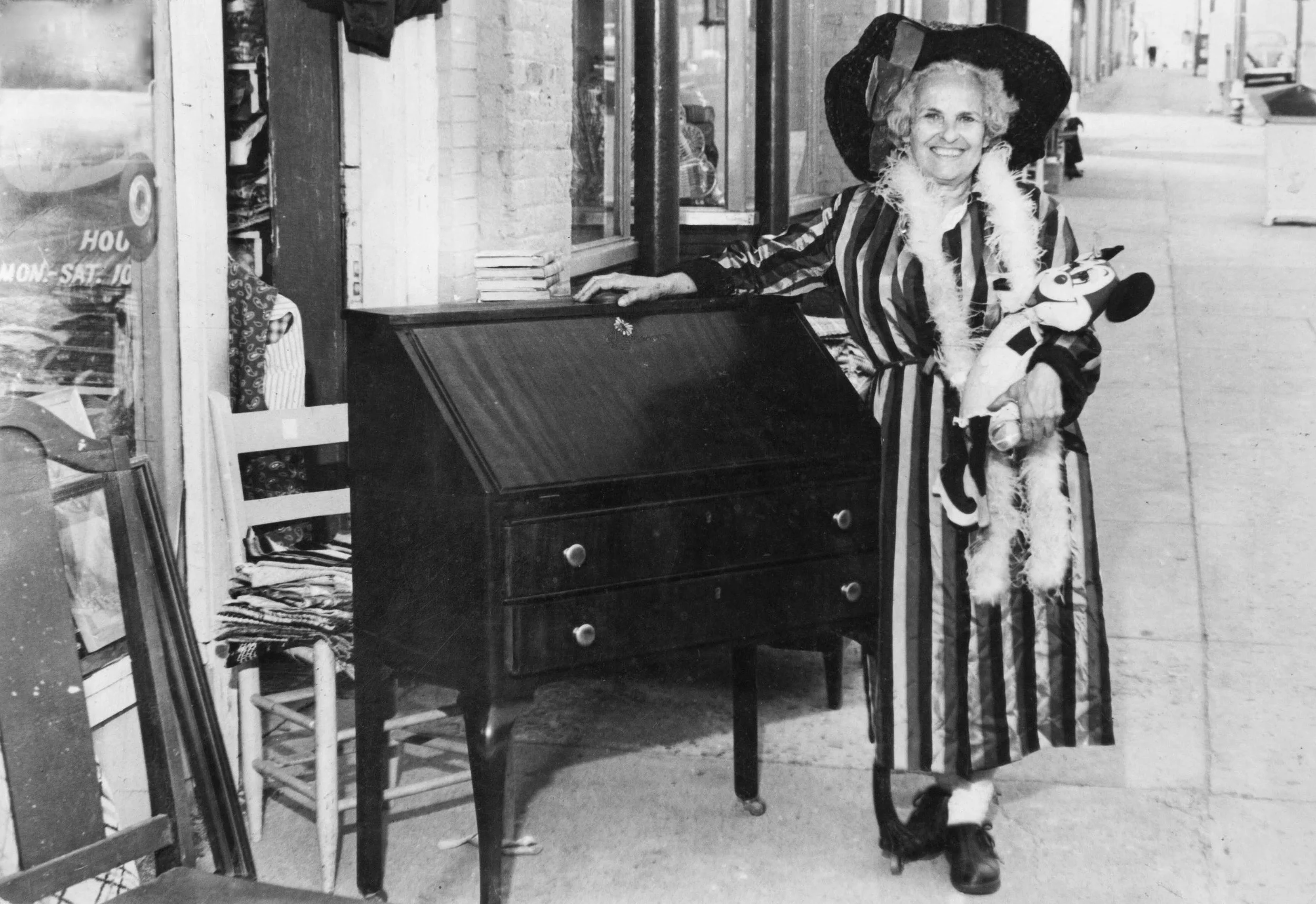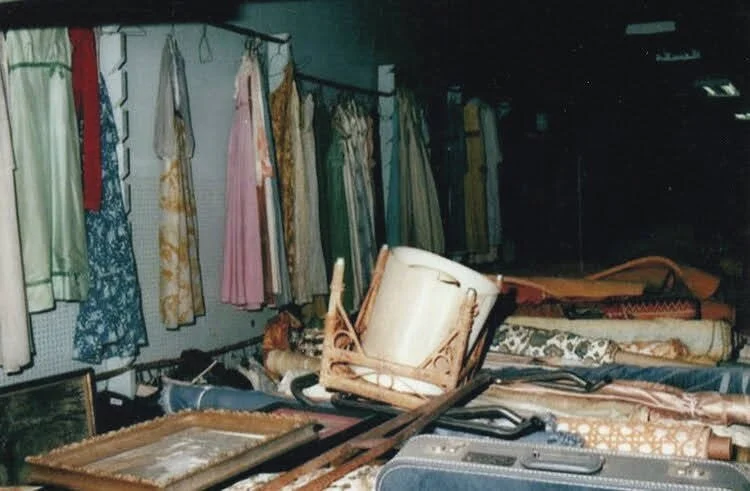Story
In 1937, Sylvia Gray and her husband Joe realized that trucks headed to New York full of new furniture made in North Carolina were returning empty. They began buying up liquidated stock from Depression-era storehouses in New York, filling the trucks with it, and repairing it out of their store at 607 South Elm Street. Before long, the business known as Carolina Sales Company outgrew its space and in 1939, the Grays bought the building across the street. The building covered two storefronts, and included a massive general retail store, a fourteen room boarding house on the second floor, and a large warehouse and various storage rooms on the third.
Following the end of WWII, the furniture store transitioned into an army surplus business. The Gray’s developed a catalog sales company that sent pup tents, army bags, and canteens to Boy Scout troops and hospitals around the country. Army surplus was pulled up on the third floor via pulley, then sorted and mended, and sent down to the general store and shipped out.
The Grays lived in the boarding house with their three children. Joe Gray unexpectedly died in 1955, leaving Sylvia alone to manage the businesses. The ten year period following Joe’s death marked the decline of the once booming surplus and catalog sales company. Sylvia began buying the ends of fabric bolts, upholstery, denim, and copious amounts of finishing ribbon from local NC textile mills and furniture factories. She shut down the boarding house to save money and boarded up the warehouse, moving the kids to the suburbs and leaving only the downstairs store for her to manage. She evolved the surplus inventory with the times and her preferences—first with a massive collection of fabrics on bolts and scraps produced in the vibrant NC textile industry. Then second hand clothing, books, toys, knick-knacks, records, dolls, dishes and housewares and glasswares, forget-me-nots and whatchamacallits, bits and bobs, notions, pieces and particulates—all eventually piled up in mountains. The first floor was filled until only a tiny path between the boxes and piles remained.
Stories say that she shopped twice a day at the local Salvation Army and Goodwill. Over time her inventory became more or less a collection, more or less a hoard, more or less an archive that detailed her tastes, interests, and perceptions of value. The collection was kept in an order with a logic only she understood. Ribbons were tied around tissue boxes stuffed with toy cars. Dolls were preserved in Roman Meal bags, patched with band-aids, strung together with various other bagged collections like dresses, jewelry, plastic toys, and dried out pens. Sylvia would buy clothing items for their buttons, cut them off, and stow them in jars. She would take piles of ribbon home with her in the evening, wash them, iron them, and roll them around a pencil. The walls were marked with scratches of calculations and phone numbers.
Stories also tell of a very unusual shopping experience. If she liked you, it was $5. If she didn’t like you for whatever reason, the same thing was $25. If she thought you were browsing she would kick you out, if she thought you were stealing she would lock you in. She loathed the use of things as “collectibles” rather than used.
Sylvia worked in the store until the day before she died. The astounding accumulation remained in a massive heap that was boarded up after her death in 1997. It was impossible to know what the mountains contained.
In 2003, Sylvia’s grandson, George Scheer and Stephanie Sherman took a southern spring break road trip with their friend Josh Boyette. The three were in a writing group called Collaborative Fiction, which put different writers together; the writers each adopted a role or character to co-develop a collaborative plot. On the trip, they decided to stop by Greensboro to see the old store that George had been telling them about. They brought a box of things back to George’s Philadelphia apartment, which completely changed the dynamic of the writer’s group. Trained on epic literature and political communities, they saw in Sylvia’s artifacts an incredible potential for play, art, and imagination. Could that space of things become a collaborative world?
In May 2003, George recruited two friends from Michigan, Josh Fox and Matt Merfert, to move with him to Greensboro. Declaring Nothing for Sale, the crew of three began sorting and sifting through the collection. They named the space Elsewhere. Stephanie Sherman and Allen Davis joined them in October. A year into the excavation and organization of things, Elsewhere became a 501(c)3 non-profit organization.
In 2005, the group launched a residency program, inviting global creatives across media and discipline to Greensboro to spend a month or more living in the space and working with and within the collection. Thanks to a grant from the Greensboro United Arts Council and the Future Fund, some movie shoots by happenstance, a commission to build a giant Lite-Brite! sculpture that paid for electrical upgrades, Elsewhere kept getting more organized and accessible. They established “the press office” to help mediate basic community functions and issue public reports. An endless stream of adventurers and volunteers from near and far came to the space for residencies and retreats, to experiment with the world of things. They developed the performance game called “Play City,” a massive larp with a button currency system that invited everyone and anyone to come in and play. It became a place for strangers and friends from near and far to meet, play, pretend, and scheme. Decades later, Elsewhere is a living museum that encompasses the work of thousands of artists, creatives, designers, and makers of all kinds who have added to and transformed an environment built on reorganizing collaboration through things.







